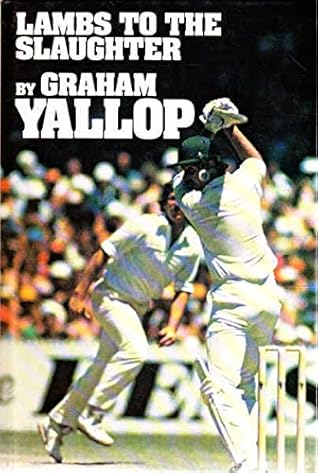Lambs to the Slaughter by Graham Yallop
Collingwood, Victoria: Outback Press, 1979 ISBN 0868882275
The 1970s was a tumultuous decade for Australian Cricket - from the disastrous loss to South Africa that cost Bill Lawry the captaincy, through to the season that Graham Yallop dissects in this book, we went through the ups of Lillee and Thomson and the downs of the WSC breakup, the latter of which had a huge impact on the Australian team and the series that Yallop describes in this book.
The 1970s was also the decade in which I grew to love cricket - my first clear memories of the game are the test series against India which was the summer before the events described in this book, and of course the whole WSC circus, which made for great television, and gave a whole new generation a love for the game. As I read this book, the pain of that summer came back to me.
By the end of the book the reader is as shell-shocked as Yallop himself seems to be by the absolute thrashing delivered to Australia by England. The Australian team was young and inexperienced, as practically all the established Australian players had defected to WSC - Yallop was captain at 26 and had only played eight Tests at the start of the summer (the most-capped player was Gary Cosier with 16), while the England team had the experience of Boycott and Willis, along with the youthful talent of Gooch, Gower and Botham; the latter two having stellar seasons.
Despite the apparent difference in ability and skill, Yallop had a reasonable hope that the Ashes would be a hard-fought series. Despite Yallop's insistence in this book that it was poor pitches and poor decisions by players and umpires that made the difference between the teams so stark, hindsight and a disengaged view would suggest that the Australian team picked for that summer, one player aside, was simply not up to scratch, and England outplayed Australia at every opportunity.
This book follows Australian cricket lovers around - there is usually a copy in any second-hand bookshop that has a sports section, and "Lambs to the Slaughter" is a phrase that is now used about the "official" Test teams during the WSC interregnum. So it's strange that it's taken me until now to read it. Perhaps I was unconsciously protecting myself from the re-lived pain of what was a very low point in our cricketing history.
There are several subjects that come out for me in this book, only some of which are raised by Yallop consciously. The first is the explosion of talent that was Rodney Hogg. With a record wicket haul in the series, he was the shining light of a poor summer for Australia. He was a famously abrasive character, and Yallop goes into some detail about how he was a difficult player to manage, which was not helped by the fact that before the series started, Yallop had never met him. The second is how little assistance was given to an Australian captain back in those days - it was only half-way through the series that the Australian Cricket Board thought that appointing a manager to the team to handle logistics, the media and so forth might be a good idea. The thought that the powers-that-be of cricket dropped an inexperienced 26 year old into the "most important job in Australia" with virtually no support is quite mind-boggling.
The final subject is Yallop himself. One very much gets the feeling that he wrote this book in anger: anger at how he was treated by the press, by the Board, and by the "cricket gods". He bemoans the inability of the Australian team to gell and put together a team performance required over the time required to consistently win a test match, but in reading the book I get no sense that he took responsibility to try and build the team in that way. I could of course be selling him short, but for this reader, more insight into the off-field activities and performance would have fleshed out his narrative - I didn't really get a sense of how the players as a unit tackled their poor performance. While the descriptions of play are useful, that is not really why we armchair cricketers read these sorts of books.
Having stated that, if you want to know the story of the 1978-9 season from an Australian viewpoint, you must read this book, which has become a bit of a minor classic.
Cheers for now, from
A View Over the Bell

No comments:
Post a Comment